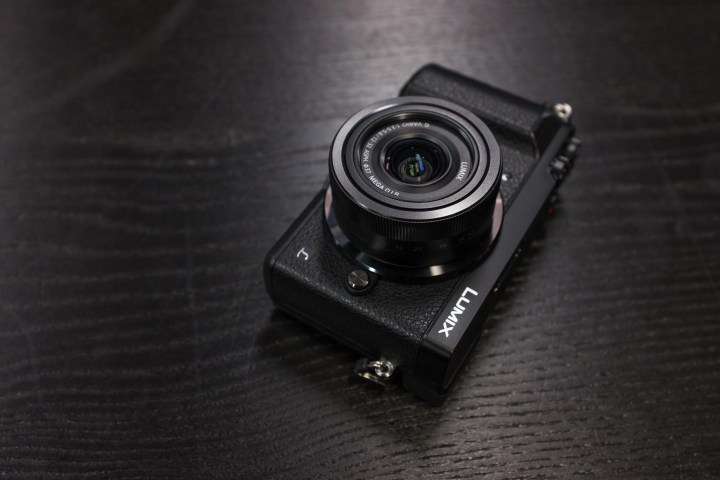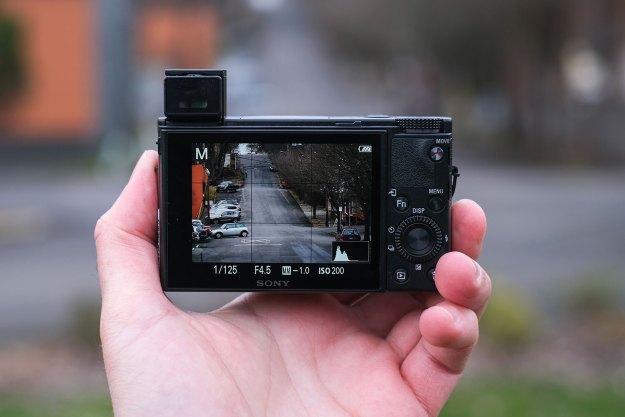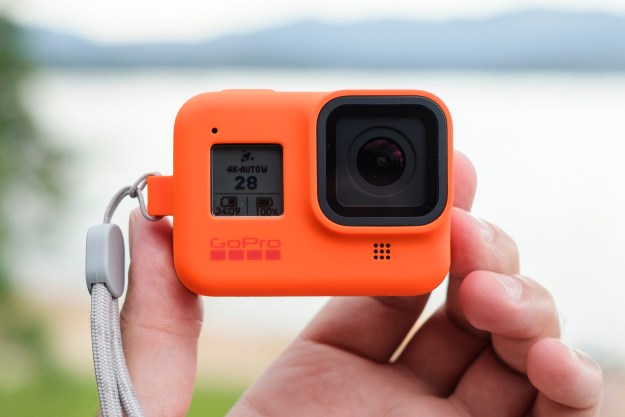If you’re looking for a camera that’s an upgrade over your phone, but also costs less than your phone, the original Sony RX100 is the best cheap camera you can buy. Cheap, of course, is relative, but the first-generation RX100 offers great image quality in a compact size that rivals the best compact cameras of today. Better than buying used, Sony keeps older models around at lower prices, so that you can save a ton of money and still get a new-in-the-box camera with a full warranty.
- At a glance
- Best cheap camera overall: Sony Cyber-shot RX100
- The best cheap mirrorless camera: Panasonic Lumix GX85
- Best Cheap DSLR: Nikon D3500
- Best cheap point-and-shoot: Canon PowerShot G9 X Mark II
- Best cheap action camera: GoPro Hero7 Silver
- Best cheap film camera: Fujifilm Instax Mini 9
- How do I get a good camera for cheap?
- How long should a digital camera last?
- What is a DSLR camera?
- What is a mirrorless camera?
Buying an older camera isn’t the only way to find a good deal, however. The other strategy is to go with newer, but lower-end model. These entry-level cameras often lack the level of control offered by higher-end models, but often have image quality equal to more expensive models. For other choices, check out the best mirrorless cameras, best Black Friday camera deals, and best point-and-shoot cameras.
At a glance
- Best cheap camera overall: Sony RX100
- Best cheap DSLR camera: Nikon D3500
- Best cheap mirrorless camera: Panasonic Lumix GX85
- Best cheap point-and-shoot camera: Canon PowerShot G9 X Mark II
- Best cheap action camera: GoPro Hero7 Silver
- Best cheap instant camera: Fujifilm Instax Mini 9
Best cheap camera overall: Sony Cyber-shot RX100

Why should you buy this: Excellent image quality for the size, and now at a good price.
Who’s it for: Casual shooters, pros on the go, and anyone looking for a step-up from a phone.
Why we picked the Sony Cyber-Shot RX100:
Released all the way back in 2012, the still-available RX100 singlehandedly started the 1-inch-type sensor revolution. Okay, maybe it wasn’t exactly a revolution, but the then-new format has gone on to be featured in many compact cameras from other manufacturers. The very same sensor even found its way into a smartphone at one point, the somewhat experimental Panasonic CM1.
Perhaps the best part, from the consumer perspective, is that even the latest, sixth-generation RX100 still uses a very similar sensor, so the 7-year-old RX100 is hardly built on outmoded technology. It would seem that once you hit max level, you can no longer level up.
While a brand-new RX100 Mark VI will cost you more than a grand, the original is less than half that. What’s more, it features a brighter lens than the new model which trades a bit of that wide aperture for a longer zoom. You won’t get 4K video like you do on the Mark VI, but the Full HD that you do get should be sufficient for the casual user. You also won’t get the Mark VI’s blazing 24 frames per second continuous burst shooting speed, but the original still puts up an impressive 10 fps — we’re certainly not complaining.
This is a camera that’s easy to grab and go, or just keep it stowed in your purse, backpack, or jacket pocket so you’re ready whenever the moment strikes. It features image quality that can only be beat by stepping up to larger-sensor, interchangeable lens cameras. With the RX100, you may technically be buying into almost seven-year-old technology, but there’s no reason it won’t feel like the latest and greatest. Unless, of course, you’ve already used a newer RX100.
Read our Sony Cyber-Shot RX100 review
The best cheap mirrorless camera: Panasonic Lumix GX85

Why should you buy this: Five-axis image stabilization, 4K video, built-in viewfinder
Who’s it for: Amateurs and enthusiasts alike, or anyone who wants a good balance of power and portability.
Why we picked the Panasonic Lumix GX85:
The Lumix GX85 is several years old at this point, but it was well ahead of its time when it was new. Now available at a significantly reduced price, you can find the GX85 in a two-lens kit for less than most new mirrorless cameras body-only. There really isn’t anything else out there that offers this kind of value.
The GX85 features Panasonic’s most compact design, making it even smaller than other already-small Micro Four Thirds cameras. Despite this, it doesn’t leave out advanced features. There’s a built-in electronic viewfinder (EVF) and a three-inch, tilting LCD screen. There are two command dials and a standard mode dial, so there’s plenty of control, as well.
Inside, the camera features a 16-megapixel sensor with 5-axis sensor-shift stabilization for sharp still photos and smooth video. Speaking of video, it shoots 4K at 24 or 30 frames per second — the only 4K camera on this list. With a stabilized lens attached, the camera makes use of both lens stabilization and sensor stabilization for even better results. In 2016, when the camera was new, these were standout features — and they still hold up today.
The still image quality won’t match up with the larger and higher-resolution sensors of some of the other cameras, but for general use, especially as a travel or vacation camera, the Lumix GX85 is hard to beat. You’d be hard-pressed to find this much tech in any other camera at this price.
Read more about the Panasonic Lumix GX85
Best Cheap DSLR: Nikon D3500

Why should you buy this: Easy to use, great image quality.
Who’s it for: Beginners, students, and first-time DSLR buyers
Why we picked the Nikon D3500:
Most people should probably lean toward a mirrorless camera, which tend to be more compact, but DSLRs still have a couple of benefits, like much longer battery life. The Nikon D3500 doesn’t have the compact footprint of the GX85, but the trade-off is a larger sensor and optical viewfinder — without drastic changes in the price. Intended for first-time DSLR buyers, the D3500 is available only as a kit (there’s no body-only option). It includes the updated, retractable version of Nikon’s 18-55mm stabilized lens which helps the camera take up less space in your bag. It’s as small as DSLRs get.
Inside, the D3500 features an excellent 24-megapixel APS-C sensor that produces some of the best images in its class — and even above its class. It can shoot at 5 frames per second continuously, which is pretty decent for an entry-level DSLR. It won’t win any awards for video, but it can shoot Full HD 1080p at up to 60 frames per second, so while you won’t get the resolution of 4K, you can get very smooth motion which is great for filming things like sports.
None of the D3500’s specs are exactly exciting by today’s standards, nor have they changed drastically from older models, but this camera still offers decent bang for the buck. Battery life has been improved slightly for this model, and Bluetooth is now included for triggering the camera remotely from a mobile device. And like any interchangeable-lens camera, the Nikon D3500 will only get better as you upgrade to higher-quality lenses down the road.
Best cheap point-and-shoot: Canon PowerShot G9 X Mark II

Why should you buy this: The ideal blend between image quality, portability, and price
Who’s it for: Beginners, enthusiasts, and anyone who wants better photos from a compact camera
Why we picked the Canon Powershot G9 X Mark II:
If the Sony RX100 is too old for your taste, the Canon Powershot G9 X Mark II is a newer model with a very similar sensor and some advanced features, and it still won’t put a big dent in your wallet. Yes, you can certainly find cheaper point-and-shoots, but they’re hard to recommend as they usually don’t offer any better image quality than your phone. With a 20-megapixel 1-inch sensor and f/2-f/4.9 lens, the G9X II delivers strong results with plenty of resolution.
A 3x optical zoom lens also gives the G9X Mark II a little more flexibility than a basic smartphone camera. The 5.3-frames-per-second continuous shooting is isn’t what we’d call impressive, but it’s certainly not bad. Video is also limited to 1080p.
At less than 9 ounces, the compact body is easy to tuck in a bag or coat pocket, making this a good travel and vacation camera. There’s no viewfinder and the LCD screen is fixed, but there’s still plenty to love.
Due to price fluctuations, the G9 X Mark II may not always be the least expensive point-and-shoot — the original RX100 is often cheaper, but the Canon is newer.
Read more on the Canon Powershot G9 X Mark II
Best cheap action camera: GoPro Hero7 Silver

Why should you buy this: GoPro quality, without the GoPro price
Who’s it for: Adrenaline junkies on a budget
Why we picked the GoPro Hero7 White:
After doing away with the low-cost Hero Session, GoPro isn’t ignoring budget-minded consumers. The Hero7 Silver is a stripped-down version of the more expensive Hero7 Black (since superseded by the Hero8 Black), but still offers most of the image quality and the same ease of use, along with all the mounting accessories the action camera giant is known for.
The Hero7 Silver delivers sharp 4K video, but at only 30 frames per second compared to the 60 of higher-end models. Still photos are also down on resolution, at 10 compared to 12 megapixels. The biggest drawback of the cheaper model, though, is that it doesn’t have GoPro’s HyperSmooth stabilization, which was introduced on the Hero7 Black and upgraded for the Hero8. The Hero7 Silver still has stabilization, but it’s not the turn-a-mountain-bike-ride-into-a-ballromm-waltz level of smoothness of HyperSmooth. But, for getting solid shots on a tiny camera that can go anywhere but won’t cost more than two Benjamins, the Hero7 White still has a lot to offer.
But GoPro’s best usability features are still there, including the great touchscreen interface and voice control. The camera is also waterproof down to 33 feet without a case, so you can pretty much take it anywhere. If you need a no-nonsense action camera at a no-nonsense price, the Hero7 Silver is the way to go.
Best cheap film camera: Fujifilm Instax Mini 9

Why should you buy this: Instant film on the cheap
Who’s it for: Anyone looking for an Instax Mini camera on a mini budget.
Why we picked the Fujfilm Instax Mini 9:
Instant film still has found a place in the digital world thanks in no small part to Fujifilm’s Instax line. The classic and timeless aesthetic, as well as the pure fun of the process, as made instant photography popular in the Instagram era.
The Fujifilm Instax Mini 9 is an affordable camera that doesn’t have a lot of frills and features, but gets the job done on a budget while still spitting out some decent photos using Instax Mini film. Exposure is automatic but brightness can be tuned manually if you need to, while a built-in flash helps out in low light. A small optical viewfinder helps compose the shot while a selfie mirror makes the camera good for party shots. There isn’t much in the way of control, but the simplicity is one of the Mini 9’s key selling points.
The upmarket Fujifilm Instax Mini 90 has more features (and a design that looks more like a camera and less like a giant wad of chewing gum), but it costs twice as much. If you want the cheapest film camera that will still capture some decent results, the Fujifilm Instax Mini 9 is worth a look.
How do I get a good camera for cheap?
The easiest way to get a good deal on a camera is to be patient. Don’t put your order in the minute a new model is released. Instead, wait to see if the manufacturer lowers the price — sometimes this happens in as little as a few months, depending on how the camera sells compared to competing models. If you don’t mind buying an older model, you can also save a lot of money by buying a previous generation camera, such as with the Sony RX100.
How long should a digital camera last?
A digital camera can last for many years, but it depends on how it’s used and cared for. Professional cameras are built to handle the elements, from rain and snow to dust and sand, but cheaper models are not made with the same level of environmental sealing. The more you use a camera, the sooner any mechanical elements like the shutter or lens aperture will wear out, too. However, those components are often tested to survive through hundreds of thousands of actuations.
What is a DSLR camera?
A DSLR is a type of interchangeable lens camera (ILC) that uses a mirror to direct light from the lens up to an optical viewfinder (OVF), allowing the photographer to see directly through the lens as if looking through a window. DSLR stands for Digital Single Lens Reflex and is the modern version of the film-era SLR; before the arrival of digital photography, this was the only way to see directly through the lens. Now, with digital sensors, this is no longer true and the DSLR has lost ground to mirrorless cameras (see below), although the optical viewfinder still has some benefits such as better battery life.
Modern DSLRs can also be shot in live view mode, where the image is previewed on the LCD screen straight from the sensor. However, performs is typically better when using the viewfinder.
What is a mirrorless camera?
A mirrorless camera is a type of interchangeable lens camera (ILC) that eliminates the bulky mirror and optical viewfinder system of a DSLR in favor a fully electronic preview system. A mirrorless camera is always in live view and may use either an electronic viewfinder (EVF) or simply no viewfinder at all, relying entirely on the LCD screen. Because of this, mirrorless cameras will drain their batteries much faster than a DSLR. In addition to weight and size savings, a mirrorless camera’s electronic preview allows for exposure and white balance simulation, so you can see exactly what you’re going to get before you take a photo.
Editors' Recommendations
- Best Sony A7 III deals: Save $300 on the full frame mirrorless camera
- The best travel cameras
- The best full-frame cameras
- The best mirrorless cameras
- The best vlogging cameras





